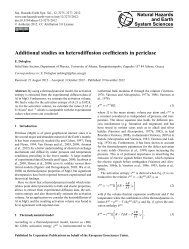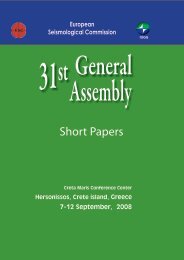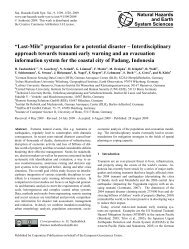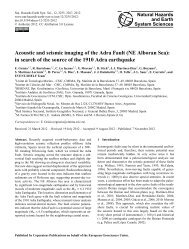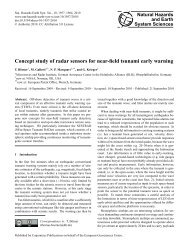implications for permafrost degradation and slope instability in the ...
implications for permafrost degradation and slope instability in the ...
implications for permafrost degradation and slope instability in the ...
You also want an ePaper? Increase the reach of your titles
YUMPU automatically turns print PDFs into web optimized ePapers that Google loves.
R. P. Daanen et al.: Rapid movement of frozen debris-lobes 1533<br />
also cause oversaturation through melt<strong>in</strong>g of <strong>the</strong> pore ice.<br />
Mudflows were recorded with time-lapse photography <strong>and</strong><br />
are best characterised by flow<strong>in</strong>g of saturated debris. Trees<br />
were observed to slide down <strong>the</strong> term<strong>in</strong>us <strong>slope</strong> with<strong>in</strong> an<br />
hour. Shrubs <strong>and</strong> trees were subsequently buried as <strong>the</strong>y<br />
accumulated at <strong>the</strong> foot of <strong>the</strong> term<strong>in</strong>us. The overall <strong>slope</strong><br />
(5–10 ◦ ) of <strong>the</strong> surround<strong>in</strong>g ground, <strong>in</strong>clud<strong>in</strong>g <strong>the</strong> <strong>slope</strong> of <strong>the</strong><br />
ground <strong>in</strong> front of <strong>the</strong> frozen debris-lobe, does not susta<strong>in</strong><br />
<strong>the</strong> movement of mud <strong>and</strong> debris, caus<strong>in</strong>g it to accumulate<br />
near <strong>the</strong> toe of <strong>the</strong> term<strong>in</strong>us. A creek dra<strong>in</strong><strong>in</strong>g <strong>the</strong> feature,<br />
however, cont<strong>in</strong>ues to carry <strong>the</strong> sediment to lower elevations<br />
towards <strong>the</strong> Dalton Highway <strong>and</strong> <strong>the</strong> Dietrich River.<br />
Table 2 conta<strong>in</strong>s a summary of <strong>the</strong> postulated controls on<br />
<strong>the</strong> <strong>for</strong>mation <strong>and</strong> behaviour of frozen debris-lobes, which<br />
are similar to those presented by Matsuoka et al. (2005).<br />
Ground ice plays a key part <strong>in</strong> <strong>the</strong> motion of creep<strong>in</strong>g <strong>permafrost</strong>.<br />
We postulate that ice <strong>for</strong>mation due to liquid water<br />
<strong>in</strong>filtration through surface cracks may be a major driv<strong>in</strong>g<br />
<strong>for</strong>ce contribut<strong>in</strong>g to <strong>the</strong> dynamic nature of frozen debrislobes.<br />
Underground ice <strong>for</strong>ms or degrades with fluctuations<br />
<strong>in</strong> available energy s<strong>in</strong>ks <strong>and</strong> sources. Climate is, <strong>the</strong>re<strong>for</strong>e,<br />
a strong factor <strong>in</strong> <strong>the</strong> stability of frozen debris-lobes <strong>and</strong> will<br />
determ<strong>in</strong>e <strong>the</strong>ir shape <strong>and</strong> occurrence. Dur<strong>in</strong>g summer, a portion<br />
of this ground ice melts <strong>and</strong>, toge<strong>the</strong>r with ra<strong>in</strong> events,<br />
provides lubrication <strong>for</strong> soil movement through gelifluction<br />
(Lewkowicz <strong>and</strong> Harris, 2005; French, 2007; Harris et al.,<br />
2008b) <strong>and</strong> mudflows.<br />
5.2 Climate change effects<br />
Glacier dynamics have been directly l<strong>in</strong>ked to climate variation<br />
<strong>in</strong> <strong>the</strong> Brooks Range. Although very different <strong>in</strong> appearance<br />
<strong>and</strong> material, we mention <strong>the</strong>m because of <strong>the</strong>ir sensitivity<br />
to regional changes <strong>in</strong> climate. Almost all glaciers <strong>in</strong><br />
Alaska are los<strong>in</strong>g mass due to climate warm<strong>in</strong>g (Calk<strong>in</strong> et al.,<br />
1998; Arendt et al., 2002, 2009; Nolan et al., 2005; Berthier<br />
et al., 2010). The movement rates of frozen debris-lobes are<br />
close to <strong>the</strong> movement rates reported <strong>for</strong> common glaciers<br />
<strong>in</strong> <strong>the</strong> Brooks Range (Nolan et al., 2005). Rock glaciers<br />
<strong>in</strong> contrast generally move at rates of millimetres to metres<br />
per year (Humlum, 1997; Roer et al., 2008; Haeberli et al.,<br />
2006; Kra<strong>in</strong>er <strong>and</strong> He, 2006; Hausmann et al., 2007; Ikeda et<br />
al., 2008). Ikeda et al. (2008) suggested that climate change<br />
causes some rock glaciers to move at faster rates. Saturation<br />
of f<strong>in</strong>e-gra<strong>in</strong>ed sediments was identified as caus<strong>in</strong>g acceleration<br />
<strong>in</strong> rock glaciers (Roer et al., 2008; Kääb et al., 2007b;<br />
Ikeda et al., 2008; Riff et al., 2008). Warm<strong>in</strong>g summers with<br />
more potential <strong>for</strong> liquid water <strong>in</strong>filtration may have contributed<br />
to <strong>the</strong> acceleration observed <strong>in</strong> <strong>the</strong> European Alps.<br />
More precipitation throughout <strong>the</strong> year or an enhanced hydrological<br />
cycle is also projected <strong>for</strong> Interior Alaska, as a result<br />
of climate change (Hunt<strong>in</strong>gton, 2006). We postulate that<br />
<strong>in</strong>creased precipitation <strong>and</strong>, thus, runoff over <strong>and</strong> through a<br />
frozen debris-lobe <strong>and</strong> its watershed, may promote erosion<br />
<strong>and</strong> <strong>the</strong> <strong>for</strong>mation of a talik with<strong>in</strong> <strong>the</strong> frozen debris-lobe.<br />
This allows <strong>for</strong> <strong>in</strong>creased <strong><strong>in</strong>stability</strong> of frozen debris-lobes<br />
dur<strong>in</strong>g <strong>the</strong> entire year, <strong>in</strong>clud<strong>in</strong>g <strong>the</strong> w<strong>in</strong>ter, <strong>and</strong> could result<br />
<strong>in</strong> movement rates far exceed<strong>in</strong>g <strong>the</strong> rate of 1 cm day −1 currently<br />
observed. This <strong>in</strong>creased erosion rate may result <strong>in</strong> <strong>the</strong><br />
release of massive amounts of sediment to areas <strong>in</strong> <strong>the</strong> valley<br />
below <strong>the</strong> frozen debris-lobe (i.e., <strong>the</strong> Dalton Highway <strong>and</strong><br />
Dietrich River).<br />
Tree-r<strong>in</strong>g observations suggest that <strong>the</strong> movement rate of<br />
frozen debris-lobes is episodic, depend<strong>in</strong>g on long-term soil<br />
<strong>the</strong>rmal behaviour, debris accumulation <strong>and</strong> short-term soil<br />
climate shifts. In particular <strong>in</strong>ter-annual snow cover variation<br />
can play a major role <strong>in</strong> controll<strong>in</strong>g those short-term variations<br />
due to <strong>the</strong> impact of snow cover on <strong>the</strong> ground <strong>the</strong>rmal<br />
regime as an <strong>in</strong>sulat<strong>in</strong>g layer.<br />
The rate of movement of frozen debris-lobes <strong>in</strong> <strong>the</strong> sou<strong>the</strong>rn<br />
Brooks Range has <strong>in</strong>creased over <strong>the</strong> last 50 yr. Even<br />
though short-term records (decade), <strong>in</strong>dicate a local cool<strong>in</strong>g<br />
trend, <strong>the</strong> long-term records (century) <strong>in</strong>dicate warm<strong>in</strong>g.<br />
Estimated climate effects on frozen debris-lobes are, at this<br />
po<strong>in</strong>t, ma<strong>in</strong>ly based on processes that we observed over a<br />
short time period. Ground temperature is expected to affect<br />
processes such as creep, gelifluction, slid<strong>in</strong>g layers, talik <strong>for</strong>mation<br />
<strong>and</strong> wetness. Warmer wetter ground is less viscous<br />
<strong>and</strong> greater pore pressure (enhanced by taliks) can reduce<br />
resistance between soil particles lead<strong>in</strong>g to potential slid<strong>in</strong>g<br />
planes <strong>in</strong> <strong>the</strong> debris <strong>and</strong> deeper wetter active layers enhance<br />
frost action <strong>and</strong> gelifluction. Thus, <strong>the</strong>se features may serve<br />
as an “early warn<strong>in</strong>g <strong>in</strong>dicator” of general <strong>slope</strong> <strong><strong>in</strong>stability</strong><br />
on hill <strong>slope</strong>s underla<strong>in</strong> by <strong>permafrost</strong>. However, longer time<br />
series <strong>and</strong> ground observations are necessary to better underst<strong>and</strong><br />
<strong>the</strong> relative importance of <strong>in</strong>dividual processes <strong>in</strong> FDL<br />
movement <strong>and</strong> vulnerability to acceleration.<br />
5.3 Frozen debris-lobe hazard<br />
Frozen debris-lobes constitute a potential hazard to <strong>the</strong> transportation<br />
corridor runn<strong>in</strong>g through <strong>the</strong> Dietrich River valley.<br />
Large quantities of <strong>slope</strong> debris have accumulated over millennia<br />
<strong>in</strong> small contribut<strong>in</strong>g valleys. This debris has very<br />
likely rema<strong>in</strong>ed frozen dur<strong>in</strong>g <strong>the</strong> last few thous<strong>and</strong> years,<br />
because <strong>the</strong> region is underla<strong>in</strong> by cont<strong>in</strong>uous <strong>permafrost</strong>.<br />
We have found evidence that <strong>the</strong>se features exhibit episodic<br />
movement <strong>and</strong> <strong>the</strong>re is some evidence this movement is controlled<br />
by <strong>the</strong>ir <strong>in</strong>ternal <strong>the</strong>rmal state.<br />
Currently, <strong>the</strong> frozen debris-lobe closest to <strong>the</strong> Dalton<br />
Highway (FDL-A) poses <strong>the</strong> largest hazard to local <strong>in</strong>frastructure.<br />
Even though its term<strong>in</strong>us is currently located outside<br />
<strong>the</strong> highway right-of-way, <strong>the</strong> frozen debris-lobe is produc<strong>in</strong>g<br />
large amounts of sediment, which has already led to<br />
<strong>the</strong> burial of culvert <strong>in</strong>lets. At <strong>the</strong> very least, recent sediment<br />
alluviation associated with frozen debris-lobes is <strong>in</strong>creas<strong>in</strong>g<br />
ma<strong>in</strong>tenance costs <strong>for</strong> culverts along parts of <strong>the</strong><br />
Dalton Highway system <strong>in</strong> <strong>the</strong> Brooks Range. In a worst<br />
case scenario, rapidly mov<strong>in</strong>g frozen debris-lobes could become<br />
a direct threat to <strong>the</strong> highway. Based on <strong>the</strong> observed<br />
www.nat-hazards-earth-syst-sci.net/12/1521/2012/ Nat. Hazards Earth Syst. Sci., 12, 1521–1537, 2012



